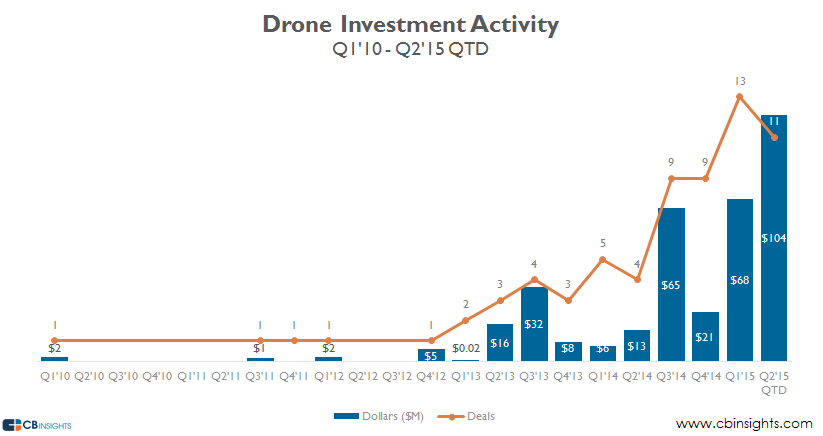2015 is quickly becoming the year of drones. So what exactly is a drone? According to the Federal Aviation Administration (FAA), a drone is an unmanned aircraft system comprising the unmanned aircraft (the drone) and all of its associated support equipment: control station, data links, telemetry, navigation equipment, etc. To fly a hobbyist drone (weighing less than 55lbs), you don’t need the FAA’s approval, as long as you keep it within your line of sight and away from populated areas/full-scale aircrafts. Flying a drone for business purposes does require FAA approval.
According to CBInsights, as of May 31, drone startups have raised more funding in 2015 than the previous three years combined (Figure 1). While the defense industry has used drones for more than a decade, they are coming into their own in the commercial space.
Figure 1: Drone Investment activity reported by CBInsights
So what exactly is a drone? A drone is an unmanned aircraft. An unmanned aircraft system is the unmanned aircraft (drone) and all of the associated support equipment such as control station, data links, telemetry, navigation equipment, etc. To fly a hobbyist drone that weighs < 55lbs, you don’t need FAA’s approval as long as you keep it within your line of sight and away from populated areas/full scale aircrafts. But, to fly a drone for business purpose, you do need to obtain FAA’s approval .
What makes drones so attractive for business purposes? They have certain unique abilities that are opening up new applications and markets every day. Drones can overcome terrain challenges and are deployable anywhere. They can also carry flexible payloads (the lighter the load the longer the flight time) and can measure and record everything in their path from an aerial perspective. The convergence of advanced smartphone software and processing capability; very high-resolution, lightweight video-capturing equipment; and advanced flight-control algorithms are unlocking new possibilities for drones.
Commercial applications include:
- Camera drones – to capture extreme sport enthusiasts’ adventures.
- Agriculture – noted as having the highest potential commercially. Drones further the precision-agriculture movement by identifying and applying pesticides and fertilizers exactly where they are needed, which is better for the environment and the farmer’s bottom line.
- Search and rescue – thermal-imaging cameras can locate missing people when the general search area is known.
- Surveying/geographic information systems (GIS) mapping.
- Unmanned cargo delivery – delivering that last-minute anniversary gift or your favorite pizza.
- Riot-control drones – loaded with pepper sprays or paintballs designed to disperse crowds. (This one makes me uneasy.)
One of the challenges with drones is the flight time. Could you imagine having to stop a search effort or your pizza not making it all the way to your house due to low battery? Limited flying time in every application scenario leads to a less desirable outcome. Although there are a few gas-powered drones, most are powered by lithium-ion (Li-ion) or lithium polymer (LiPo) rechargeable batteries. The many ways to extend flight time include making the payload as light as possible, flying in the right weather conditions, and choosing a higher capacity/higher-cell-count battery pack. Mainstream drone batteries have evolved from 3-4 cells in series to higher capacity greater than 5 cells in series. TI has a variety of battery chargers, gauges and protectors to cover the spectrum of drone application needs, including a device that can perform charging, gauging and protection all in one package – the bq40Z60.
That was a quick overview of drones, their applications and outlook. Even though every new generation of drone increases run time, you always want to remember to carry an extra battery pack or two so the fun can continue uninterrupted. Stay charged!
To learn more about TI’s battery management portfolio, please visit www.ti.com/battery


